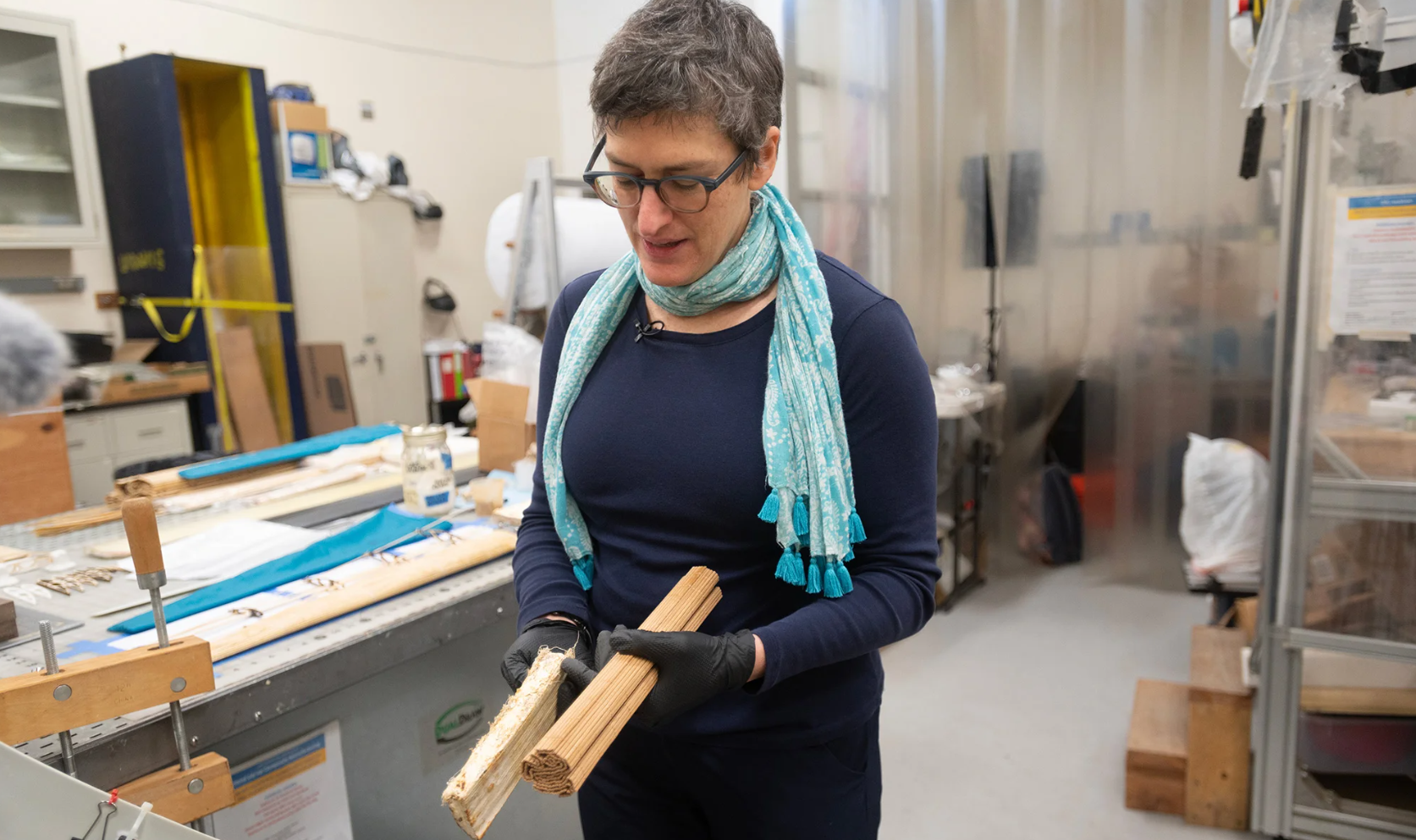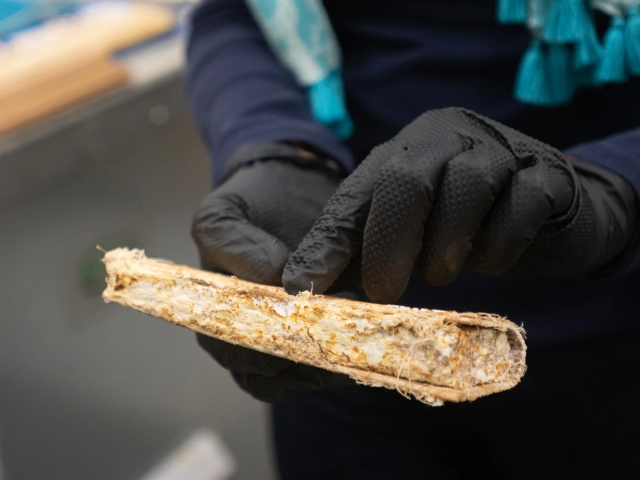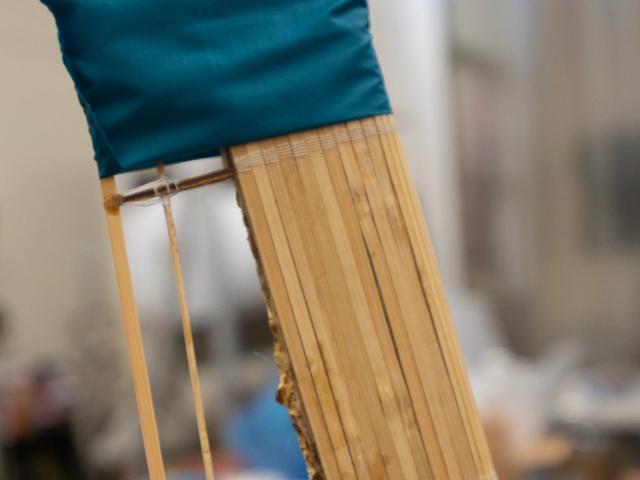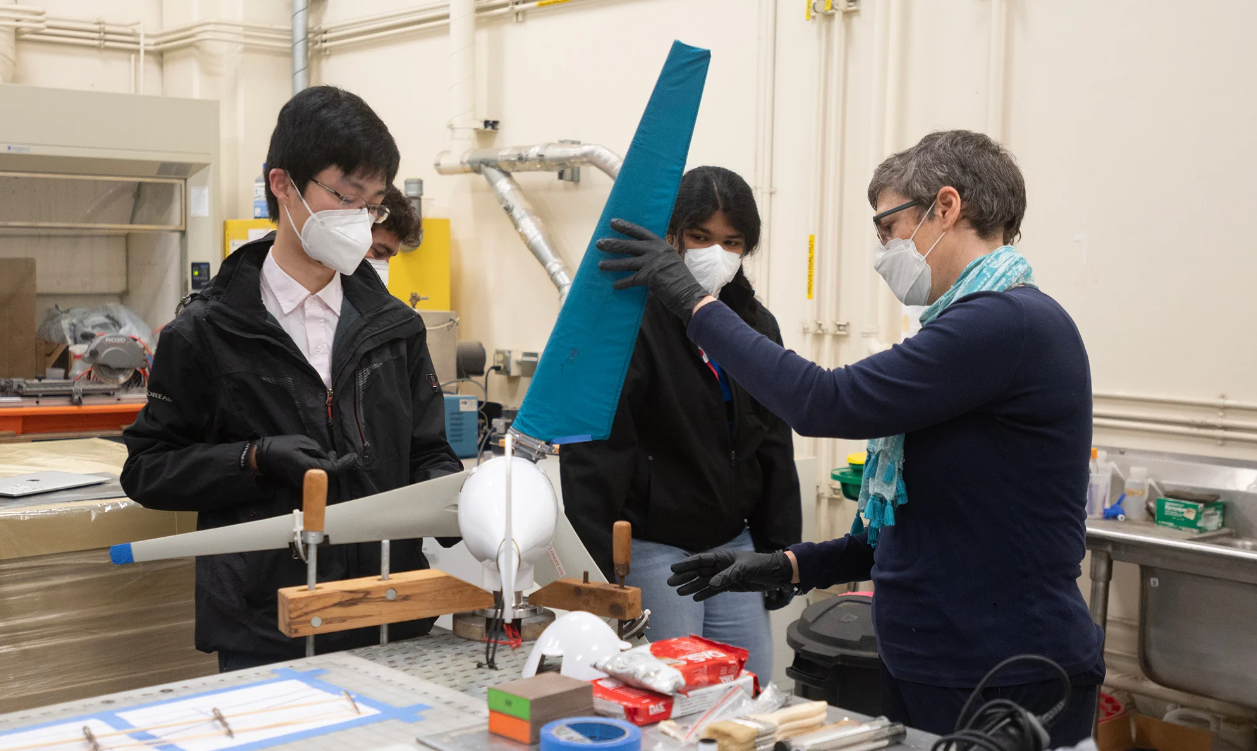A Sustainable Solution: Compostable Wind Turbine Blades
Blades Made From Bamboo and Mycelium Could Keep a Growing Number of Wind Blades Out of Landfills
It is the year 2035. In a world facing climate catastrophe, the human enterprise is powered by fields of wind farms, with turbine blades made from fast-growing grasses and the roots of a million-year-old fungus.
It may sound like a scene from a climate-fiction movie, but polymer composites expert Valeria La Saponara, a professor in the UC Davis Department of Mechanical and Aerospace Engineering, has a vision to develop compostable, ecologically sound wind turbine blades from bamboo and mycelium, the fungal rootlike system that bears mushrooms. With seed funding from the College of Engineering’s Next Level strategic research vision and a grant from UC Davis Sustainability’s The Green Initiative Fund behind the initial phase of research, La Saponara, co-principal investigator Michele Barbato in the Department of Civil and Environmental Engineering, and a diverse team of students and researchers in the Advanced Composites Research, Engineering and Science laboratory are testing a prototype on campus.
The environmental challenge of wind turbine blade disposal
Wind is one of the fastest growing sources of renewable energy in California and around the globe. It is a key part of California’s path to carbon neutrality by 2045. China, which accounts for more than half of global wind power, is planning to build a wind farm that could power 13 million homes by 2025 as it works toward its 2060 net-zero goal.
The expanding role of wind is largely good news. But as this key source of renewable energy grows, an environmentally sound solution is needed for the exponentially growing number of wind blades bound for landfills. Wind turbine blades are huge: The average rotor diameter in the U.S. in 2021 was 418 feet, so a single blade is almost as big as a Boeing 747’s wingspan. Designed to be resilient against heavy winds and weather conditions, the blades have a lifespan of about 20 years before they are retired or replaced. Most are constructed using a composite structure of fiberglass/epoxy built on top of balsa wood, which adds stability and flexibility. Recycling options are very limited, costly and incur the additional carbon footprint impacts of transportation.
Most wind turbine blades end up in landfills. In the U.S. alone, more than 2 million tons of decommissioned blades are projected to be sent to landfills by 2050 according to a recent study; globally, the mass of all the blades expected to be retired by 2050 may be as high as 43 million metric tons. The use of balsa wood is an additional, devastating ecological impact. Rapid growth in the wind power industry has caused overlogging in the Ecuadorean Amazon rain forest, resulting in unchecked deforestation and societal harm to Indigenous communities in the region. Some manufacturers have been switching to PET plastics, adding to the millions of tons of PET waste in the environment.
Designing compostable wind turbine blades
For La Saponara, wind blade pollution is an urgent problem.
“We want to have clean energy, but clean energy cannot pollute the environment, and it can’t cause deforestation,” La Saponara said. “If we’re doing clean energy, it’s not to deforest the Amazon rainforest. We want to be good citizens for everybody.”

La Saponara envisions a compostable wind turbine blade built with woven bamboo, mycelium and biomass from the agricultural waste from California’s Central Valley in place of fiberglass and balsa wood. She first began working with mycelium in 2019, when she sought an alternative to the fossil-based plastics of bike helmet liners. Mycelium is an amazingly versatile substance, and La Saponara’s lab has been researching possibilities to leverage it as a low-carbon emission, low-toxicity, compostable alternative to nondegradable materials like polyurethane and acrylic.
Scaling up to a project as large and complex as wind turbine blades is a next-level move involving a highly collaborative group.
“The project is mushrooming,” La Saponara joked. “Creating this design requires work from multiple disciplines.”
In addition to co-principal investigator Barbato, who will support structural development, and research engineer Shuhao Wan, the project includes a diverse group of student researchers in engineering and design.
Combining sustainable materials: bamboo and mycelium
As luck would have it, La Saponara has a highly multidisciplinary researcher in her team, who is also a skilled bamboo artisan: Shuhao Wan, the lab’s instrumentation and design research engineer, has worked with bamboo as a hobby, crafting model ships in bottles. Wan is testing different ways to weave the bamboo reeds.


Meanwhile, the team is working on optimizing media for growing and attaching the mycelium layer. Mycelium is an amazing material because it can be grown where it’s going to be used — as long as the conditions are right. The fungal mass can thrive in waste streams from coffee grounds to discarded plastics, with its feedstock influencing its properties. But mycelium doesn’t eat everything, and naturally anti-fungal bamboo is not on the menu. The team is testing to incorporate post-consumer textile waste, which may offer the bonus outcome of growing the mycelium using waste otherwise bound for landfill.
Testing mycelium-bamboo wind blades
The team recently built a prototype to begin testing.
“We want to do structural testing to find out how fast a rotation we can have, how much power we can generate,” La Saponara said.

The mycelium-bamboo composite will replace blades on a commercial 1-kilowatt turbine set up near the STEEL Lab, part of the Western Cooling Efficiency Center, away from central campus. La Saponara said they also will test the resilience of these blades, making sure they can withstand 85-mile-per-hour winds.
“Once we have the proof of concept for 1 kilowatts, which is a reasonable amount of power, then we can start working with companies for the commercialization of this concept for distributed energy applications,” La Saponara said.
These are early days toward the eventual goal of scaling the blades for global use. In fact, the blades could help in areas affected by natural disasters, where energy solutions are needed quickly, and wind power could be paired up with solar panels.
“What we’re doing right now doesn’t work anymore,” she said. “We’re at a tipping point in the environment, and our next generation are the ones who will pay the highest price. Ultimately, there’s no way we can talk about environmental engineering without talking about environmental justice.”
Meet the team behind UC Davis’ sustainable wind turbine blade project
Co-Principal Investigator Michele Barbato, professor in the Department of Civil and Environmental Engineering, will support the structural modeling of the tower, advising post-doctoral fellow Prakash Singh Badal.
Shuhao Wan, the lab’s instrumentation and design research engineer and a mechanical and aerospace engineering alum from UC Davis, is investigating ways to build the blades, including structuring the bamboo layer. Shuhao will be starting his Ph.D. at the University of Michigan in fall 2023.
Shree Nagarkar, a Ph.D. student in mechanical and aerospace engineering, started investigating the aerodynamics and fluid-structure interaction behavior of these flexible wind turbine blades. More recently, the aerodynamics modeling of the wind turbine blades is being carried out by undergraduate student researcher Fernando Hernandez Sanchez (a mechanical and aerospace engineering graduating senior, and a pilot), advised by wind turbine aerodynamics expert Camli Badrya, assistant professor in the Department of Mechanical and Aerospace Engineering.
Undergraduate student researchers Nicholas Gallo, Dominic Soufl, Connor Prescott (at different stages of their mechanical and/or aerospace engineering majors) and Shivani Torres-Lal (chemical engineering student) have been working on various aspects of the project, from construction of the blade to preparation and testing of the mycelium/bionass.
Alejandra Ruiz, Master of Fine Arts student in the Department of Design, is investigating mycelium growing on textiles. Ruiz is mentored by Christina Cogdell, professor in the Department of Design and a biodesign expert.
Aidelen Montoya, California State University, San Marcos, in museum studies, arts and history, a 2022 summer research undergraduate student who is studying mycelium growing from paper for various applications. Montoya is mentored by Professor Lucy HG Solomon in CSUSM’s Department of Art, Media and Design.
Media Resources
This In Focus story is a part of the Science and Climate series.
Read more about the project and see more photos in November 2022 article 'This Project is Mushrooming.'
